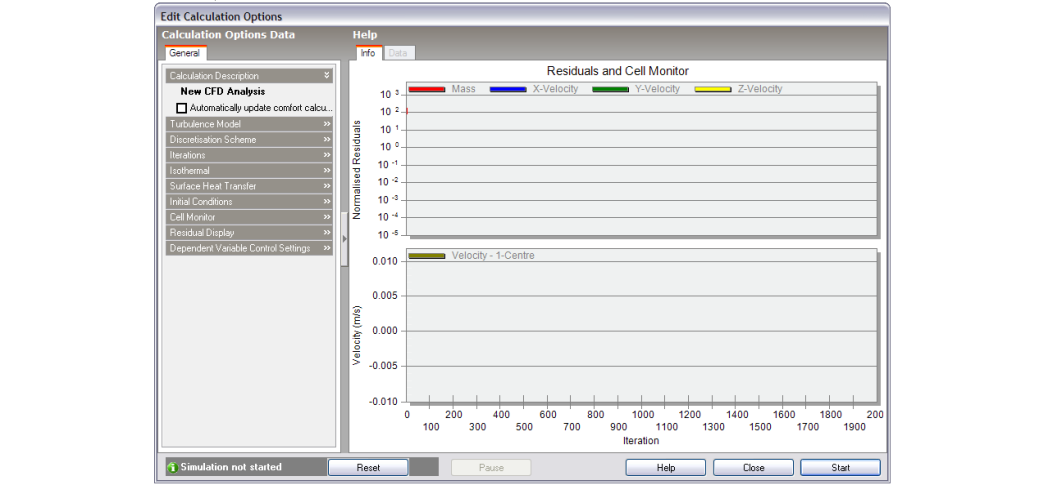

To run the calculations, click on the Update calculated data tool. If a problem is found with the grid generation, the CFD G Related Topicsrid
Related Topicsrid  Related TopicsStatistics dialog is displayed showing the error. There are three possible error conditions:
Related TopicsStatistics dialog is displayed showing the error. There are three possible error conditions:
If no problem is encountered in creating the grid, the ‘Edit Calculation Options’ dialog will be displayed:

The Edit Calculation Options dialog is divided into two main sections, the Residuals and Cell Monitor graphs and the Calculation Options Data panel.
There are also a group of buttons at the bottom of the dialog, which allow you to control the calculations:
Start, or if the calculations have been paused, re-start the calculations.
Interrupt or pause the calculations. Once the calculations have been paused, the calculation dialog can be temporarily closed in order to review the results.
After pausing the calculations, the calculations may then be re-initialised to start from scratch. If the solution is found to diverge and you pause the calculations to decrease the velocity false time steps, you will then need to reset the calculations before re-starting.
The calculation settings panel incorporates the following settings:
The following turbulence model options are available:
where k= turbulence kinetic energy and e = dissipation rate of turbulence kinetic energy
k and e are both derived from partial differential equations which are in turn derived from a manipulation of the Navier-Stokes equations.
The following discretisation schemes are available:
This is the maximum number of iterations conducted by the outer iterative calculation loop (see ‘CFD Calculations and Convergence’ section). The calculations will terminate when the number of iterations reaches this value regardless of whether or not the solution has converged.
Temperature is assumed to be constant throughout the calculation domain and the energy equation is removed from the calculations.
The following surface heat transfer options are available:
In some cases, a faster solution can be achieved by setting the initial conditions closer to the final expected conditions.
Select any defined cell monitor point and associated dependent variable to be displayed on the cell monitor (see Setting Up CFD Cell Monitor Points section).
Select the dependent variables and/or mass for which residuals are to be displayed in the residuals monitor. The mass residual is similar to the dependent variable residuals but is extracted from a continuity equation mass balance for each cell and is the most significant residual in terms of indicating a successfully converged solution.
The calculations involve a nested iterative scheme whereby dependent variable equations are solved iteratively within an overall outer iterative loop (see CFD Calculations and Convergence section). The dependent variable control settings enable control inner iterative dependent variable calculations.
The number of iterations used for the calculation of the dependent variable.
The finite difference equation set is formulated in the form of a transient equation set although the calculations are essentially a ‘snap-shot’ in time. The reason for this formulation is that the transient term behaves as a very effective relaxation method, which can slow the change in dependent variables in order to arrive at a more stable solution. The false time step is the time step used in the pseudo-transient term of the dependent variable equation. For forced convection flows, a ‘best-guess’ optimal false time step is automatically calculated for velocities, however for buoyancy driven flows, a default value of 0.2 is used. Reducing the false time step has the effect of slowing down the change in the dependent variable and can be a helpful remedy for unstable solutions.
This is used in the ‘text book’ relaxation method, which can be used to allow only a proportion of the calculated value of the current iteration dependent variable to be assigned to the variable. However, the false time step is normally the preferred method of achieving under-relaxation.
The outer iterative calculation loop is repeated until the finite difference equations for all cells are satisfied by the current values of the appropriate dependent variables, at which point the scheme is said to have ‘converged’. The dependent variable residual is the maximum residual quantity for the equation balance across all cells in the domain. The solution is deemed to have converged for each dependent variable when the residual is less than the termination residual.
The CFD Calculations and Convergence section gives an overview of the calculation methodology that will help in understanding the concepts used to initialise, control and monitor the calculations.